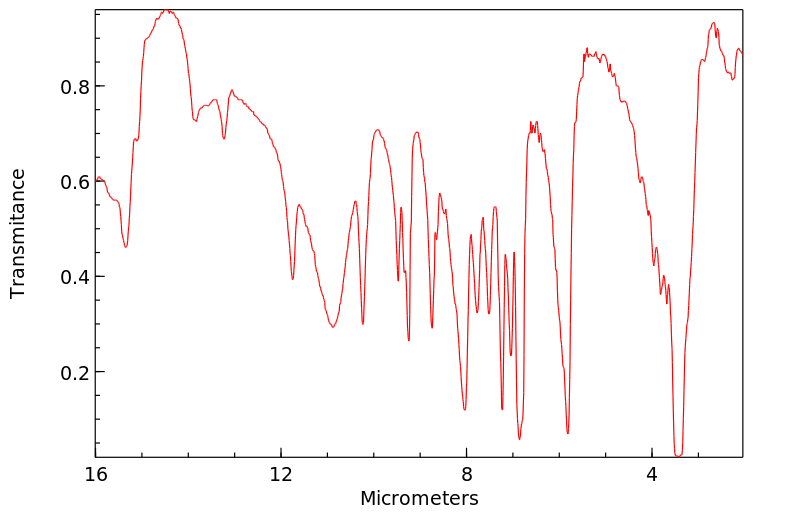2-碘丙酸 | 598-80-1
中文名称
2-碘丙酸
中文别名
——
英文名称
2-iodopropionic acid
英文别名
α-Iodopropionic acid;2-Iodopropanoic acid
CAS
598-80-1
化学式
C3H5IO2
mdl
MFCD01757050
分子量
199.976
InChiKey
KZLYQYPURWXOEW-UHFFFAOYSA-N
BEILSTEIN
——
EINECS
——
-
物化性质
-
计算性质
-
ADMET
-
安全信息
-
SDS
-
制备方法与用途
-
上下游信息
-
文献信息
-
表征谱图
-
同类化合物
-
相关功能分类
-
相关结构分类
物化性质
-
熔点:45.0-45.5 °C
-
沸点:244.6±23.0 °C(Predicted)
-
密度:2.073 g/cm3(Temp: 18 °C)
计算性质
-
辛醇/水分配系数(LogP):1
-
重原子数:6
-
可旋转键数:1
-
环数:0.0
-
sp3杂化的碳原子比例:0.666
-
拓扑面积:37.3
-
氢给体数:1
-
氢受体数:2
SDS
上下游信息
反应信息
-
作为反应物:描述:参考文献:名称:Abderhalden; Guggenheim, Chemische Berichte, 1908, vol. 41, p. 2853摘要:DOI:
-
作为产物:参考文献:名称:Oxidative coupling of carboxylic acid dianions: the total synthesis of (.+-.)-hinokinin and (.+-.)-fomentaric acid摘要:DOI:10.1021/jo00388a036
文献信息
-
Photoiodocarboxylation of Activated C═C Double Bonds with CO<sub>2</sub> and Lithium Iodide作者:Rossella Mello、Juan Camilo Arango-Daza、Teresa Varea、María Elena González-NúñezDOI:10.1021/acs.joc.8b02162日期:2018.11.2The photolysis at 254 nm of lithium iodide and olefins 1 carrying an electron-withdrawing Z-substituent in CO2-saturated (1 bar) anhydrous acetonitrile at room temperature produces the atom efficient and transition metal-free photoiodocarboxylation of the C═C double bond. The reaction proceeds well for terminal olefins 1 to form the new C–I and C–C σ-bonds at the α and β-positions of the Z-substituent
-
Radical addition of 2-iodoalkanamide or 2-iodoalkanoic acid to alkenols using a water-soluble radical initiator in water. A facile synthesis of γ-lactones作者:Hideki Yorimitsu、Katsuyu Wakabayashi、Hiroshi Shinokubo、Koichiro OshimaDOI:10.1016/s0040-4039(98)02391-0日期:1999.1of 2-iodoacetamide and 5-hexen-1-ol in water at 75 °C in the presence of a water-soluble radical initiator, 4,4′-azobis(4-cyanopentanoic acid), provided γ-(4-hydroxybutyl)-γ-lactone in 95% yield. The use of 2-iodoacetic acid in place of 2-iodoacetamide also gave the same γ-lactone in 93 % yield.
-
Radical Addition of 2-Iodoalkanamide or 2-Iodoalkanoic Acid to Alkenes with a Water-Soluble Radical Initiator in Aqueous Media: Facile Synthesis of<i>γ</i>-Lactones作者:Hideki Yorimitsu、Katsuyu Wakabayashi、Hiroshi Shinokubo、Koichiro OshimaDOI:10.1246/bcsj.74.1963日期:2001.10Radical reactions in water or aqueous ethanol using a water-soluble radical initiator are described. Heating a mixture of 2-iodoacetamide and 5-hexen-1-ol in water at 75 °C in the presence of a water-soluble radical initiator, 4,4′-azobis(4-cyanopentanoic acid), afforded 5-(4-hydroxybutyl)dihydrofuran-2(3H)-one in 95% yield. The use of 2-iodoacetic acid in place of 2-iodoacetamide also gave the same γ-lactone in 93% yield. The reaction of 2-iodoacetamide with 1-octene in aqueous ethanol was initiated by 2,2′-azobis(2-methylpropanamidine) dihydrochloride to provide γ-decanolactone. Employing water as a solvent is crucial to obtain lactone in satisfactory yield.
-
Platinum(II) mediated oxidation of remote CH bonds in functionalized organic molecules作者:Naomi Basickes、Ayusman SenDOI:10.1016/0277-5387(94)00329-d日期:1995.1-CH δ -CH for alcohols and σ -CH ⪡ β -CH γ -CH ⪖ δ -CH for the acids. The reactions are thought to proceed by the initial coordination of the functional group followed up the formation of an intermediate platinacylce upon CH activation. The observed regioselectivity arises from the tendency to form the metallacycle with the least ring strain. It was possible to make the oxidations catalytic in
-
A NEW SYNTHESIS OF α-IODO CARBOXYLIC ACID USING IODINE-COPPER SALT作者:C. Akira Horiuchi、J. Yasuo SatohDOI:10.1246/cl.1984.1509日期:1984.9.5Direct α-iodination of some carboxylic acids, namely, acetic acid, propionic acid, butyric acid, and valeric acid, using iodine-copper salt, gave the corresponding α-iodo carboxylic acid in high yield. This new synthetic method afforded several advantage over classical α-iodo carboxylic acid procedures.
表征谱图
-
氢谱1HNMR
-
质谱MS
-
碳谱13CNMR
-
红外IR
-
拉曼Raman
-
峰位数据
-
峰位匹配
-
表征信息
同类化合物
(甲基3-(二甲基氨基)-2-苯基-2H-azirene-2-羧酸乙酯)
(±)-盐酸氯吡格雷
(±)-丙酰肉碱氯化物
(d(CH2)51,Tyr(Me)2,Arg8)-血管加压素
(S)-(+)-α-氨基-4-羧基-2-甲基苯乙酸
(S)-阿拉考特盐酸盐
(S)-赖诺普利-d5钠
(S)-2-氨基-5-氧代己酸,氢溴酸盐
(S)-2-[[[(1R,2R)-2-[[[3,5-双(叔丁基)-2-羟基苯基]亚甲基]氨基]环己基]硫脲基]-N-苄基-N,3,3-三甲基丁酰胺
(S)-2-[3-[(1R,2R)-2-(二丙基氨基)环己基]硫脲基]-N-异丙基-3,3-二甲基丁酰胺
(S)-1-(4-氨基氧基乙酰胺基苄基)乙二胺四乙酸
(S)-1-[N-[3-苯基-1-[(苯基甲氧基)羰基]丙基]-L-丙氨酰基]-L-脯氨酸
(R)-乙基N-甲酰基-N-(1-苯乙基)甘氨酸
(R)-丙酰肉碱-d3氯化物
(R)-4-N-Cbz-哌嗪-2-甲酸甲酯
(R)-3-氨基-2-苄基丙酸盐酸盐
(R)-1-(3-溴-2-甲基-1-氧丙基)-L-脯氨酸
(N-[(苄氧基)羰基]丙氨酰-N〜5〜-(diaminomethylidene)鸟氨酸)
(6-氯-2-吲哚基甲基)乙酰氨基丙二酸二乙酯
(4R)-N-亚硝基噻唑烷-4-羧酸
(3R)-1-噻-4-氮杂螺[4.4]壬烷-3-羧酸
(3-硝基-1H-1,2,4-三唑-1-基)乙酸乙酯
(2S,4R)-Boc-4-环己基-吡咯烷-2-羧酸
(2S,3S,5S)-2-氨基-3-羟基-1,6-二苯己烷-5-N-氨基甲酰基-L-缬氨酸
(2S,3S)-3-((S)-1-((1-(4-氟苯基)-1H-1,2,3-三唑-4-基)-甲基氨基)-1-氧-3-(噻唑-4-基)丙-2-基氨基甲酰基)-环氧乙烷-2-羧酸
(2S)-2,6-二氨基-N-[4-(5-氟-1,3-苯并噻唑-2-基)-2-甲基苯基]己酰胺二盐酸盐
(2S)-2-氨基-N,3,3-三甲基-N-(苯甲基)丁酰胺
(2S)-2-氨基-3-甲基-N-2-吡啶基丁酰胺
(2S)-2-氨基-3,3-二甲基-N-(苯基甲基)丁酰胺,
(2S)-2-氨基-3,3-二甲基-N-2-吡啶基丁酰胺
(2S,4R)-1-((S)-2-氨基-3,3-二甲基丁酰基)-4-羟基-N-(4-(4-甲基噻唑-5-基)苄基)吡咯烷-2-甲酰胺盐酸盐
(2R,3'S)苯那普利叔丁基酯d5
(2R)-2-氨基-3,3-二甲基-N-(苯甲基)丁酰胺
(2-氯丙烯基)草酰氯
(1S,3S,5S)-2-Boc-2-氮杂双环[3.1.0]己烷-3-羧酸
(1R,5R,6R)-5-(1-乙基丙氧基)-7-氧杂双环[4.1.0]庚-3-烯-3-羧酸乙基酯
(1R,4R,5S,6R)-4-氨基-2-氧杂双环[3.1.0]己烷-4,6-二羧酸
齐特巴坦
齐德巴坦钠盐
齐墩果-12-烯-28-酸,2,3-二羟基-,苯基甲基酯,(2a,3a)-
齐墩果-12-烯-28-酸,2,3-二羟基-,羧基甲基酯,(2a,3b)-(9CI)
黄酮-8-乙酸二甲氨基乙基酯
黄荧菌素
黄体生成激素释放激素(1-6)
黄体生成激素释放激素 (1-5) 酰肼
黄体瑞林
麦醇溶蛋白
麦角硫因
麦芽聚糖六乙酸酯
麦根酸







